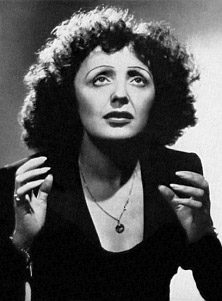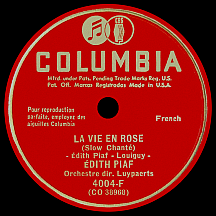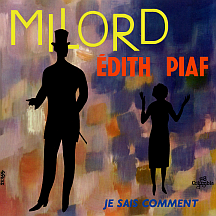ÉDITH PIAF
La Vie en Rose
20-year-old Édith Piaf broke down in tears at the end of the 1936 film La Garçonne. She was acting, of course, but it may not have been particularly difficult to bring about such an emotional finale for her onscreen debut. She had experienced far more low points than high during her first two decades of life, being passed off from one dispassionate relative to another, spending a good deal of her formative years on the streets of Paris and giving birth to, then losing, her only child, who had died just a few months earlier. While better times were to come, so would sadness and tragedy persist. A great many admirers, at the time and more recently, developed a fascination with the events of Édith's brief life while feeling deeply moved by her vocal performances. Among the French, and doubtless millions of others, she is considered the greatest singer of all time.
Her mother, Annetta Giovanna Maillard (born in Italy, she spent some time in the 1910s and '20s as a cafe singer using the name Line Marsa), gave birth to daughter Édith Giovanna Gassion on December 19, 1915 in Paris's Belleville quarter. Alone at the time and unable to hail a taxi, she gave birth on the street with the help of two policemen, or so the legend goes (the birth certificate sets the location at the nearby Hôpital Tenon). Not long after, Édith was sent to live with Annetta's mother, Emma Mohamed, who mistreated her, then moved in with her other grandmother, Léontine Descamps, after which the burden was transferred to her father. Louis-Alphonse Gassion, a circus entertainer who often performed acrobatics on Paris streets, made the adolescent Édith part of his act, but he was demanding and often abusive, so she left him and became a solo street singer. A relationship at age 16 with day laborer/street hustler Louis Dupont resulted in the birth of a daughter, Marcelle Léontine Dupont, in February 1933; after contracting meningitis, she died in July 1935.
Louis Leplée, a shady entrepreneur who owned the club Le Gerny at Champs-Élysées, noticed the young street singer and, impressed with the big voice that came from a girl of such petite stature (she stood about four-foot-ten), booked her to perform at his club as La Môme Piaf (meaning mother sparrow or "The Little Sparrow"). Her first recordings were made under this name for Polydor Records in 1936; "Les Môme De La Cloche" was backed with "L'Etranger" ("The Stranger"), the latter written in part by Marguerite Monnot, who would compose many songs for the chanteuse. Songwriter Raymond Asso was also a staunch supporter. Leplée turned up dead several months later and Édith became a murder suspect, though no evidence surfaced to support such a charge. A small part in La Garçonne came later in the year and through a series of 78 RPMs and personal appearances she became a star. Famous French playwright Jean Cocteau penned Le Bel Indifférent for Édith, a very successful stage production in 1940. Montmartre sur Seine, her second film and first with star billing, came the following year. As a number of notable individuals aided in the development of her career, so did Piaf help others, among them actor-singers Yves Montand and Charles Aznavour and a nine-member singing group she would soon be performing with.
After World War II ended, she began touring on other continents, becoming very rich and famous as a result. She was top-billed again in the 1946 film Étoile sans Lumière (Star Without Light). Les Compagnons de la Chanson ("Companions of Song") had been together a couple of years when she took them under her wing; they sang with her on Jean Villard's "Les Trios Cloches" ("The Three Bells"), a major hit in France that year (a version in English without Piaf became a hit in the U.S. six years later). All of Édith's recordings were on the Columbia label in France and many other parts of the world including the U.S. She had written "La Vie en Rose" (translated as "Life in Pink") in the latter months of the war; the song's success in France in 1947 was only the beginning as its popularity spread throughout many countries over the next few years.
During a trip to the States in 1947 she met Algerian-born French boxer Marcel Cerdan; the two fell in love (despite his being married). Édith had her third starring role in a film, 1948's Neuf Garçons, un Cœur (Nine Boys, One Heart); close friends Les Compagnons were her nine co-stars. During this time she was frequently seen in public with Cerdan and later referred to him as the love of her life. In October 1949, he died in a plane crash at Portuguese island São Miguel. She recorded Monnot's "Hymne à L'Amour" in May 1950 as a testament to their love. Personal problems seemed to escalate; over the next few years she was in as many as three automobile accidents, suffering various injuries, leading to excessive use of drugs and alcohol to deal with the pain.
As television became increasingly popular in the U.S., Édith's career flourished; she was a featured guest on the premiere of the variety series Four Star Revue in October 1950 and within two weeks her English version of "La Vie en Rose" (recorded just three months earlier) was a top 30 hit. In September 1952 she made her first appearance on Ed Sullivan's hit show Toast of the Town wearing her signature black dress, singing "Padam, Padam" and a cover of Frankie Laine's popular "Jezebel." Sullivan had her back two months later to perform "La Vie." Marriage to singer Jacques Pills around that time became little more than a four year endurance lap. Her friendship with Sullivan lasted longer, as he invited her to appear on the retitled Ed Sullivan Show whenever she came to America. She obliged three times over the next few years, performing one of her strangest singles in September '56, an against-type cover of Jerry Leiber and Mike Stoller's "Black Denim Trousers and Motorcycle Boots" that had been a hit that year for Los Angeles-based trio The Cheers.

Movie appearances, all of them French-made (Paris chate tourjours! (Paris Still Sings) in '51, Boum sur Paris in '53), were non-starring ones, usually featuring her in musical segments; in 1955 she performed in director Jean Renoir's French Cancan. Piaf's most high-profile appearances were on Sullivan's show, where she was seen three additional times in 1959, the same year her final film role, top-billed, came in Les amants de demain. In May of that year she recorded the exuberant French song "Milord" (composed by Monnot and Georges Moustaki) at Capitol Records' studio in Manhattan (she'd signed with Capitol in the U.S. but stayed with Columbia back home). Dozens of singers covered the song; Dalida hit number one in Germany in 1960 with a German-language version. In March '61, Piaf's original made the Billboard charts, facing competition from Teresa Brewer's English-language cover (Bobby Darin later had a minor hit with his French version in '64).
Though only in her forties, Édith's health was gradually failing. She continued performing regularly in Paris and scored a massive late-career hit in 1961 with "Non, Je Ne Regrette Rien," which spent several weeks at number one on the French charts between January and June. The preference in the U.S. was for the B side, her alternate-lyric take on Ernest Gold's theme from "Exodus," the year's biggest multiple-artist hit. Yet ultimately "No Regrets (Non, Je Ne Regrette Rien)" (as it was credited in some countries) stood the test of time, nearly on the high level of "La Vie en Rose."
In 1962 she met a ten-years-younger, Paris-born, Greek singing hopeful, Theophanis Lamboukas, helped get his career going, changed his professional name to Theo Sarapo...and married him in October. Their duet recording of "À Quoi Côa Sert L'Amour" ("What Good is Love?") was popular in various parts of the world. Theo's 20-year-old sister Christina originally pursued a career as a beautician, but after the couple invited her to live with them, the plan took a turn towards music. Édith suggested Christie Laume as a stage name and made a hard-to-refuse offer: Christie would be the opening act for her concerts. Though nervous and uncertain of her talent, the newcomer led off several shows, doing three songs before introducing the main attraction. It worked out pretty well...that is, until the Little Sparrow's life ended. On October 10, 1963, while staying at her vacation home at Plascassier in the south of France, the 47-year-old star passed away. Jean Cocteau, who was 73, his heart weakened in recent years, died two days later after hearing of his dear friend's death.
Theo and Christie continued their individual singing careers for the remainder of the decade. The "Ye-ye" era of girl singers was perhaps nearing its end when Christie signed with the Odeon label in 1967, resulting in several recordings over the next couple of years. On August 28, 1970, Theo Sarapo died in an automobile accident at age 34. He was buried in the Père Lachaise Cemetery in Paris, next to his world-famous wife, Édith Piaf, and her daughter Marcelle.



